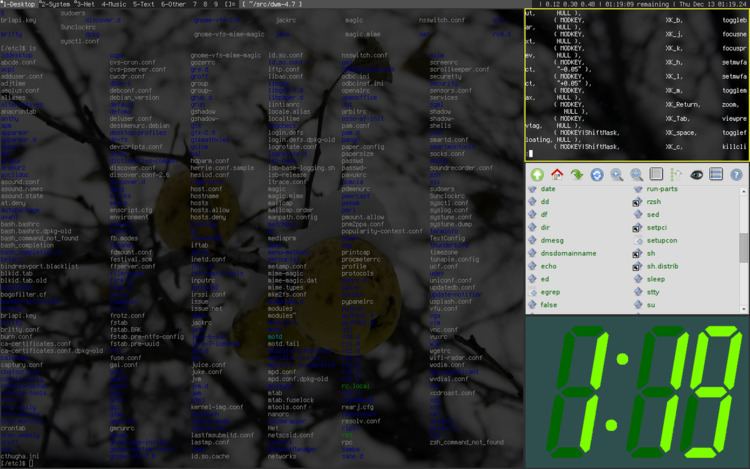 | ||
In computing, a tiling window manager is a window manager with an organization of the screen into mutually non-overlapping frames, as opposed to the more popular approach of coordinate-based stacking of overlapping objects (windows) that tries to fully emulate the desktop metaphor.
Contents
Xerox PARC
The first Xerox Star system (released in 1981) tiled application windows, but allowed dialogs and property windows to overlap. Later, Xerox PARC also developed CEDAR (released in 1982), the first windowing system using a tiled window manager.
Various vendors
Next in 1983 came Andrew WM, a complete tiled windowing system later replaced by X11. Microsoft's Windows 1.0 (released in 1985) also used tiling (see sections below). In 1986 came Digital Research's GEM 2.0, a windowing system for the CP/M which used tiling by default. One of the early (created in 1988) tiling WMs was Siemens' RTL, up to today a textbook example because of its algorithms of automated window scaling, placement and arrangement, and (de)iconification. RTL ran on X11R2 and R3, mainly on the "native" Siemens systems, e.g., SINIX. Its features are described by its promotional video. The Andrew Project (AP or tAP) was a desktop client system (like early GNOME) for X with a tiling and overlapping window manager.
Microsoft Windows
The built-in Microsoft Windows window manager has, since Windows 95, followed the traditional stacking approach by default. It can also act as a rudimentary tiling window manager.
To tile windows, the user selects them in the taskbar and uses the context menu choice Tile Vertically or Tile Horizontally. However, the wording of these options is misleading. Choosing Tile Vertically will cause the windows to tile horizontally but take on a vertical shape, while choosing Tile Horizontally will cause the windows to tile vertically but take on a horizontal shape. These options were later changed in Windows Vista to Show Windows Side by Side and Show Windows Stacked, respectively. Windows 7 adds the ability to drag windows to either side of the screen to create a simple side-by-side tiled layout, or to the top of the screen to maximize.
The Windows 8 GUI introduced a new basic tiling window manager. In Windows 10, users are able to tile Windows by quarters.
History
The first version (Windows 1.0) featured a tiling window manager, partly because of litigation by Apple claiming ownership of the overlapping window desktop metaphor. But due to complaints, the next version (Windows 2.0) followed the desktop metaphor. All later versions of the operating system stuck to this approach as the default behaviour.
X Window System
In the X Window System, the window manager is a separate program. X itself enforces no specific window management approach and remains usable even without any window manager. Current X protocol version X11 explicitly mentions the possibility of tiling window managers. The Siemens RTL Tiled Window Manager (released in 1988) was the first to implement automatic placement/sizing strategies. Another tiling window manager from this period was the Cambridge Window Manager developed by IBM's Academic Information System group.
In 2000, both larswm and Ion released a first version.
List of tiling window managers for X
Others
Tiling applications
Although tiling is not the default mode of window managers on any widely used platform, most applications already display multiple functions internally in a similar manner. Examples include email clients, IDEs, web browsers, and contextual help in Microsoft Office. The main windows of these applications are divided into "panes" for the various displays. The panes are usually separated by a draggable divider to allow resizing. Paned windows are a common way to implement a master–detail interface.
Developed since the 1970s, the Emacs text editor contains one of the earliest implementations of tiling. In addition, HTML frames can be seen as a markup language-based implementation of tiling. The tiling window manager extends this usefulness beyond multiple functions within an application, to multiple applications within a desktop. The tabbed document interface can be a useful adjunct to tiling, as it avoids having multiple window tiles on screen for the same function.
